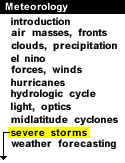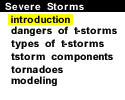
|

Graphic developed by: Dan Bramer
The Severe Storms Module is a combination of two elements. The first is the NOAA Severe Storms Spotters Guide. The second is a section recently added to discuss the efforts and results of modeling severe storms. The Severe Storms Spotters Guide contains supplemental instructional resources and a program designed to familiarize meteorologists and advanced severe storm spotters with the basic "building blocks" of convective storm structure. The focus of the training series is the development of a thunderstorm "spectrum" and a discussion of the physical characteristics and severe weather potential of the various storm types in the spectrum.
| Sections
Last Update:05/15/99 |
Dangers of Thunderstorms
Includes: lightning, floods, hail, winds and tornadoes.
Types of Thunderstorms
Components of Thunderstorms
Tornadoes
Modeling
Acknowledgments
|
The critical role of atmospheric dynamics and thermodynamics in determination of storm type is stressed. We will take a close look at the storms themselves; from the small, summer storms capable of producing dangerous "microbursts" to the large "supercell" storms which spawn destructive tornadoes.
The navigation menu (left) for this module is called "Severe Storms" and the menu items are arranged in a recommended sequence, beginning with this introduction. In addition, this entire web server is accessible in both "graphics" and "text"-based modes, a feature controlled from the blue "User Interface" menu (located beneath the black navigation menus). More information about the user interface options, the navigation system, or WW2010 in general is accessible from About This Server.

Upper Air Features |
|

Dangers of T-storms |



